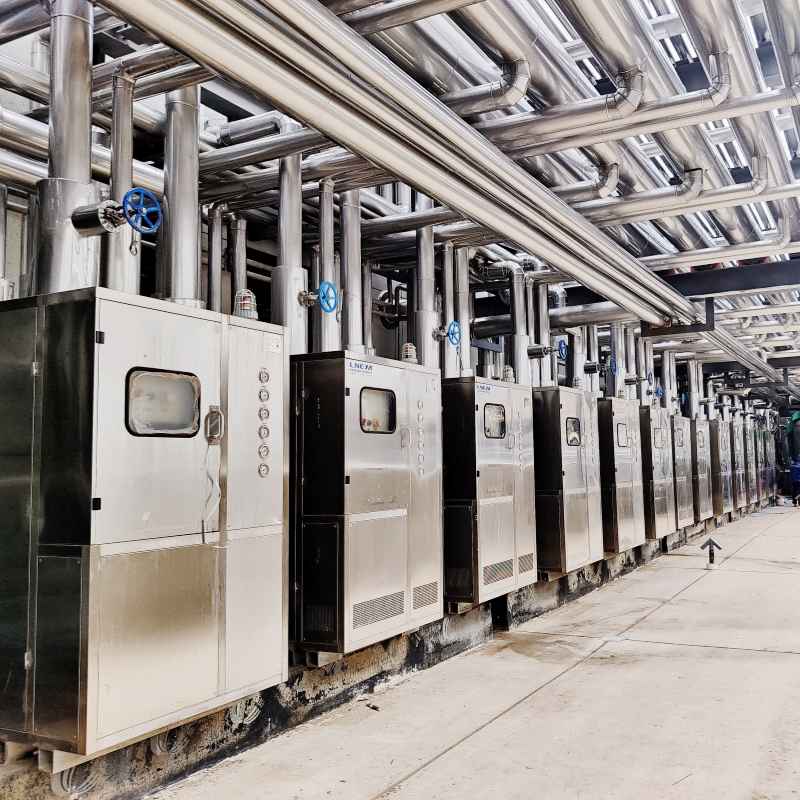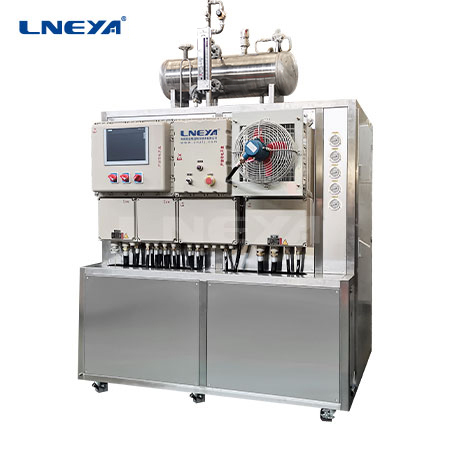Reactor Cooling Heating System for Pharmaceutical Factory
The main reasons are as follows:
- Precise control of reaction conditions
In the process of drug synthesis and manufacturing, many chemical reactions are extremely temperature sensitive and need to be carried out at specific temperatures. The cooling and heating system can ensure that the temperature inside the reaction vessel remains within the required range, ensuring reaction efficiency and product quality.
- Improve reaction efficiency
Appropriate temperature control can accelerate reaction rates, shorten production time, and improve efficiency. Some reactions proceed faster at high temperatures, while others require low temperatures to avoid side reactions.
- Ensure product quality
Temperature fluctuations may lead to side reactions or impurity formation, affecting drug purity and efficacy. The cooling and heating system can maintain a stable temperature, ensuring product consistency and high quality.
- Ensure safety
Some reactions release a large amount of heat, and if not cooled in time, it may lead to temperature runaway and cause danger. The cooling system can quickly remove excess heat and prevent accidents from occurring.
- Adapt to different response needs
There are multiple reactions involved in the pharmaceutical process, each with different temperature requirements. The cooling and heating system can be flexibly adjusted to meet the needs of different reactions.
When choosing the direct or secondary heat exchange type of TCU (temperature control unit), it needs to be determined based on specific application requirements, process conditions, and equipment characteristics. Here is a comparison and selection suggestion between the two:
Direct Type TCU
- Characteristic:
- Direct heating/cooling: The medium flows directly through the reaction vessel without undergoing secondary heat exchange.
- Simple structure: The system has fewer components and is relatively easy to install and maintain.
- Fast response speed: Rapid temperature adjustment, suitable for processes that require rapid temperature changes.
Secondary heat exchange Type TCU
- Characteristic:
- Indirect heating/cooling: The temperature of the reaction vessel is indirectly controlled through a heat exchanger, and the medium does not directly contact the reactants.
- Complex structure: The system includes additional heat exchangers, making installation and maintenance more complex.
- Accurate temperature control: suitable for processes that require extremely high temperature control.
Choose Suggestions
1.Process requirements:
- If rapid temperature change and medium compatibility are required, a straight through type can be selected.
- If high temperature control accuracy is required or the medium is incompatible, choose the secondary heat exchange type.
2.Media compatibility:
- When the medium is compatible, the straight through type is more convenient.
- When the medium is incompatible, the secondary heat exchange type is safer.
3.Temperature range:
- The medium low temperature or medium high temperature process can be selected as a straight through type.
- The extreme temperature process should choose the secondary heat exchange type.
4.Cleanliness requirements:
- For high cleanliness requirements, the secondary heat exchange type is more suitable.
5.Space and maintenance:
- Due to limited space or a desire to simplify maintenance, a straight through option is available.
- Acceptable for complex installation and maintenance, optional secondary heat exchange type.
In summary, the cooling and heating system of the reaction kettle is crucial in the pharmaceutical process, ensuring precise control of reaction conditions, improving efficiency, ensuring product quality and safety, and adapting to diverse production needs. Choosing a straight through or secondary heat exchange TCU requires comprehensive consideration of process requirements, medium compatibility, temperature range, cleanliness requirements, and space maintenance. The straight through type is suitable for situations with rapid temperature change, medium compatibility, and limited space; The secondary heat exchange type is suitable for processes with high-precision control, incompatible media, or extreme temperatures.
TCU PRODUCTS-120℃~250℃
- see more
TCS Series
TCS integrated Reactor temperature control system First, advanced design conceptThis solution is based on the advanced process control system SIMATIC PCS 7 design. It refers to the advanced concept of real-time release testing in…
- see more
SR Series
TCU temperature control system USES the existing heat (such as steam, cooling water and cryogenic liquid – the “primary”) system infrastructure are integrated into the single fluid system was used to control the temperature o…
- see more
ZLF Series
Special temperature control system for reaction kettle -120~250℃ 士1°C TCU temperature control system USES the existing heat (such as steam, cooling water and cryogenic liquid – the “primary”) system infr…
loading…
已经是到最后一篇内容了!
 LNEYA Industrial Chillers Manufacturer Supplier
LNEYA Industrial Chillers Manufacturer Supplier













